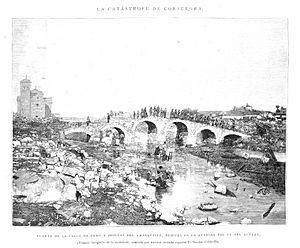Consuegra Dam facts for kids
Quick facts for kids Consuegra Dam |
|
|---|---|
| Official name | Presa Romana de Consuegra |
| Location | Toledo province, Castilla-La Mancha, Spain |
| Coordinates | 39°25′46.4″N 3°39′17.5″W / 39.429556°N 3.654861°W |
| Opening date | 3rd or 4th century |
| Dam and spillways | |
| Impounds | Amarguillo (Guadiana basin) |
| Height | 4.8 m |
| Length | >632.0 m |
| Width (base) | 2.6 m |
The Consuegra Dam is an ancient Roman dam located in the Toledo province of Castilla–La Mancha, Spain. This dam was built a very long time ago, around the 3rd or 4th century AD. It sits on the Amarguillo River, just upstream from the town of Consuegra.
Even though the dam is less than 5 meters (about 16 feet) high, it is incredibly long, stretching over 600 meters (nearly 2,000 feet). The water held back by the dam likely had two main uses. It helped supply water to the town of Consuegra. It also provided water for irrigating nearby farmland.
Consuegra's History
The town of Consuegra was important even before the Romans arrived. During Roman times, it was a significant settlement. It even had a circus, which was a large arena for chariot races and other public events. This shows how important Consuegra was in the Roman Empire.
The Amarguillo River and Floods
The Amarguillo River, where the dam is located, does not always flow steadily. Sometimes it has very little water, and other times it can have a lot. In 1891, a huge flood from the Amarguillo River caused serious damage to the town of Consuegra. It is possible that the ancient Consuegra Dam also suffered damage during this powerful flood.
Protecting the Dam
Today, the Consuegra Dam is recognized as an important historical site. It is protected by a special heritage listing called Bien de Interés Cultural. This means it is considered a cultural asset and efforts are made to preserve it for future generations.
See also
 In Spanish: Presa Romana de Consuegra para niños
In Spanish: Presa Romana de Consuegra para niños
- List of Roman dams and reservoirs
- Roman architecture
- Roman engineering


